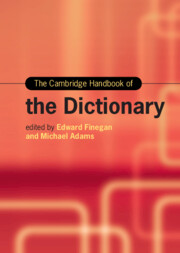Book contents
- The Cambridge Handbook of the Dictionary
- Cambridge Handbooks in Language and Linguistics
- The Cambridge Handbook of the Dictionary
- Copyright page
- Contents
- Figures
- Tables
- Contributors
- Acknowledgments
- Introduction
- Part I Types of Dictionaries
- Part II Dictionaries as Books
- Part III Dictionaries and Ideology
- Part IV Dictionaries and Domains of Use
- Chapter 20 Dictionary Audiences
- Chapter 21 Dictionaries and Intellectual History
- Chapter 22 Dictionaries and Social History
- Chapter 23 Linguistics and Philology in Dictionaries
- Chapter 24 Dictionaries as Literary Artifacts
- Chapter 25 Dictionaries and Editors
- Chapter 26 Lexicography and the Law
- Part V The Business of Dictionaries
- Part VI The Future of Dictionaries
- References: Dictionaries
- References: Secondary Works
- Index
Chapter 20 - Dictionary Audiences
from Part IV - Dictionaries and Domains of Use
Published online by Cambridge University Press: 19 October 2024
- The Cambridge Handbook of the Dictionary
- Cambridge Handbooks in Language and Linguistics
- The Cambridge Handbook of the Dictionary
- Copyright page
- Contents
- Figures
- Tables
- Contributors
- Acknowledgments
- Introduction
- Part I Types of Dictionaries
- Part II Dictionaries as Books
- Part III Dictionaries and Ideology
- Part IV Dictionaries and Domains of Use
- Chapter 20 Dictionary Audiences
- Chapter 21 Dictionaries and Intellectual History
- Chapter 22 Dictionaries and Social History
- Chapter 23 Linguistics and Philology in Dictionaries
- Chapter 24 Dictionaries as Literary Artifacts
- Chapter 25 Dictionaries and Editors
- Chapter 26 Lexicography and the Law
- Part V The Business of Dictionaries
- Part VI The Future of Dictionaries
- References: Dictionaries
- References: Secondary Works
- Index
Summary
User studies have generated considerable insight into the functional dimensions of dictionaries, but dictionaries are cultural artifacts as well as utilitarian tools and must be regarded as having not only users but also audiences. A review of the historical development of commercial and institutional dictionaries reveals the different audiences implicitly or explicitly targeted by dictionary producers over time. Scholarship on the usage of monolingual dictionaries shows that the attributes audiences expect in a dictionary and the power of the dictionary as a cultural institution vary significantly among countries and communities. In the twenty-first century, the advent of electronic dictionaries, dictionary licensing, and social media introduced new complications to the relationship between dictionaries and their audiences. The blurring of boundaries around the monolingual dictionary happened at a time when debates over words and their meaning were increasingly prominent in public discourse over topics such as gender, race, and sexuality, sometimes resulting in media controversies. To remain relevant in this landscape, dictionaries must now consider audience expectations as well as user needs.
Keywords
- Type
- Chapter
- Information
- The Cambridge Handbook of the Dictionary , pp. 409 - 420Publisher: Cambridge University PressPrint publication year: 2024

